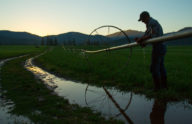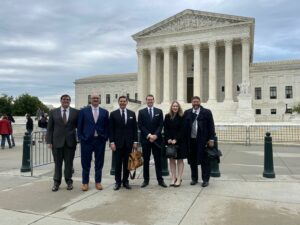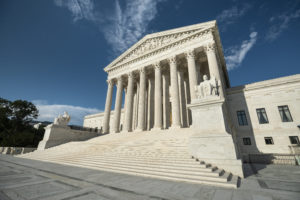The Hill: Biden administration jumps the gun on ‘navigable waters’ rule

The Biden administration recently published its final definition of “navigable waters” — establishing the scope of federal power to regulate private property under the Clean Water Act. This is the relevant agencies’ — Environmental Protection Agency (EPA) and the U.S. Army Corps of Engineers — fourth attempt at crafting such a definition in the past 15 years. That history of confusion raises the question: Why finalize this rule now, when the Supreme Court is poised to provide much needed clarity and stability in Sackett v. EPA? (The case was brought by Pacific Legal Foundation, where we work.)
It is hard to see how the definition will do anything more than confuse matters more, further victimizing a regulated public that must conform, at enormous cost, to the government’s shifting standards.
Some background is necessary. The Clean Water Act authorizes the EPA and Army Corps to regulate “discharges” into “navigable waters.” The phrase “navigable waters” limits the authority granted to the agencies. If a water feature is a “navigable water,” the agencies can regulate. If not, they cannot. This limiting principle is especially important given that the statute authorizes draconian penalties.
However, under regulations promulgated in 1986, the agencies decided they could regulate activities in and around every wetland or other damp patch of land in the country. The Supreme Court struck down this limitless “land-is-waters” approach in 2006, in Rapanos v. United States (also brought by Pacific Legal Foundation). Alas, the court could not reach consensus on an appropriate test for agency authority.
Justice Antonin Scalia, writing for a plurality, issued a clear standard that limited regulation to “waters” as understood in the conventional sense of the term — that is, relatively permanent or continuously flowing bodies of water. He also allowed for the regulation of some wetlands. But since wetlands are by definition not “waters,” he concluded that they can be regulated only incidentally to true waters — that is, where there exists a continuous surface water connection between the wetland and the water, such that it is difficult to tell where one ends and the other begins.
Justice Anthony Kennedy wrote separately and came up with a “significant nexus” test: Wetlands and other features need only have a (vaguely defined) significant nexus to some downstream water to be regulated.
Since the Rapanos case, every presidential administration has tried — and failed — to implement the Clean Water Act in accordance with that decision.
The Bush administration issued guidance to implement the 1986 regulations in accordance with aspects of both tests. This approach caused much confusion. Although the Scalia test provided clear bounds on federal authority, nothing stopped the agencies from relying on Kennedy’s amorphous and expansive “significant nexus” test to justify federal jurisdiction over private property.
In 2015, the Obama administration promulgated a rule that took the significant nexus test as a starting point to claim sweeping regulatory authority. Because of its patent illegality and the issuance of several injunctions, it never took effect throughout the entire country.
Enter the Trump administration. It first repealed the 2015 rule and then finalized a new definition of “navigable waters” that relied upon Scalia’s test. The Trump rule was ultimately vacated nationwide by a district court in Arizona.
Now the Biden administration has made yet another attempt, promising a durable rule. Yet the rule, published on Jan. 18, basically codifies the unworkable Bush-era approach by making some allowance for Scalia’s test, while primarily relying on the broad significant nexus test. This obvious shortcoming has spurred congressional reaction in the form of a Congressional Review Act resolution to disapprove the rule.
There is a better way. At present, the Supreme Court has an opportunity to revisit its fractured opinion in Rapanos and provide clarity in Sackett v. EPA. After all, we know from years of experience that the Biden administration’s approach cannot provide the promised durability.
For 15 years, the EPA and Army Corps have prevented the Sacketts from building a home on their modest residential lot near Priest Lake, Idaho. In 2007, shortly after the court ruled in the Rapanos case, the EPA relied on the significant nexus test to assert authority over purported wetlands on the lot. The Sacketts were understandably surprised. Their lot contains no bodies of water, nor any surface water connections to any body of water. It is surrounded by roads and a built-out residential development.
The Sacketts filed suit challenging the government’s claimed authority. They have argued that the significant nexus test is illegal. The court’s decision is expected by fall of 2023.
So, why would the Biden administration finalize its rule now? The significant nexus test underpins the Biden rule in every vital respect. And should the Sacketts prevail in their argument that the significant nexus test is illegal, a major amendment — if not a total rewrite — would be necessary. Even in the absence of a complete victory for the Sacketts, the Biden rule, which claims to be “informed by relevant Supreme Court case law,” would be outdated immediately upon issuance of a Supreme Court decision addressing federal wetlands authority.
The EPA has argued that the new rule will provide guidance and clarity, obviating the need for the Supreme Court to resolve the issues in Sackett. But the rule does little more than formally codify the Bush-era approach — the same regime giving rise to the dispute in the Sacketts’ case.
This is no trifling issue. The agencies have again failed to recognize that as this game of regulatory ping-pong unfolds, it is ordinary Americans attempting to engage in everyday land use who must shoulder the burden of the government’s ever shifting standards.
This op-ed was originally published at The Hill on February 13, 2023.






